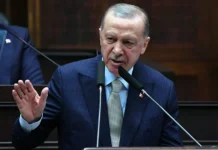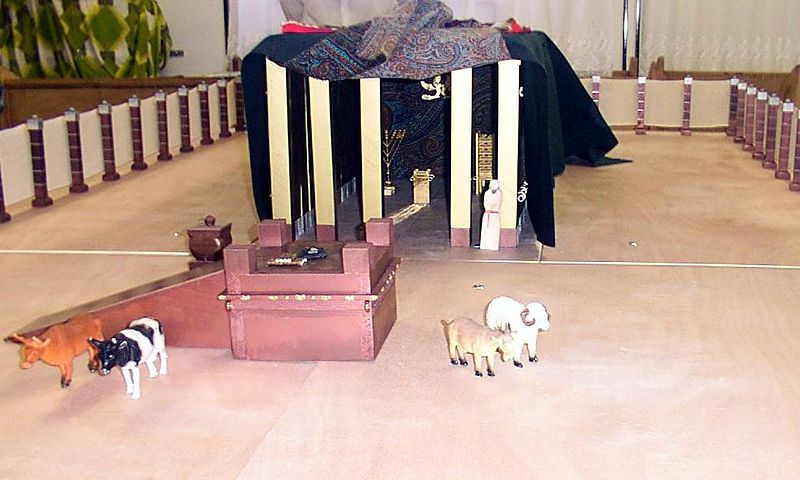In the opening verse of our Parasha the word death appears twice (“מוֹת and וַיָּמֻתוּ”), as well as HaShem’s name twice (“יְהוָה and לִפְנֵי-יְהוָה”). We also see an extra word describing the two sons of Aharon “Shenei” (“שני” – two), as its written “אחרי מות שני בני אהרון”. We already know that Aharon had two sons that died, as they were mentioned before. Why then the Torah writes “two”? This comes to teach us few lessons for generations to come. No one shall ever commit such a sin of sacrificing Ketoret, as Aharon’s two sons committed, and we should learn from their six sins. We also learn from the three words “Shenie Benei Aharon” (“שְׁנֵי בְּנֵי אַהֲרןֹ” – Aharon’s two sons) a secret code. The last letter of each word spells the word “Ya’yein” (“יין” – wine), alluding to the fact that they were intoxicated when they entered the Mishkan (Tabernacle). Also interesting to point out that the word “Sod” “סוד” – secret) and the word “Ya’yein” (“יין” – wine) have the same numerical value, 70. The Zohar explains that the wine which was drunk by Nadav and Avihu was the wine which Noah drank, and indeed it was the wine which Adam and Eve drank! HaRav Shlomo Elyashiv Zt”l (the grandfather of the HaRav Shalom Yosef Elyashiv Zt”l), explains that Nadav and Avihu were great religious leaders, and they were trying to bring about forgiveness for the sin of Adam, to do a Tikun. This is the reason that they used “Adam’s grapes”. They wished to rectify his sin, for the entire Bnei-Yisrael.
The Midrash teaches us that Nadav and Avihu committed six sins and we learn this from the word “Otam” (“אותם” – them) written in Parashat Shemini, verse 10:2. The letter “Vov” (“ו”), that has a numerical velue of 6, is added. We also notice that the word “Mot” (“מוֹת” – “Death”) is written with the letter “Vov” (“ו”) as a vowel, which the Torah usually omits, alluding to the six sins as well. The six sins committed by Nadav and Avihu are:
- They brought unholy fire into the Mishkan.
- Thy brought unholy Ketoret, in order to attain wealth.
- They were intoxicated in the Mishkan.
- They never got married thinking it was beneath their status.
- They taught Halacha (ruling) without asking Moshe.
- They never asked permission to offer sacrifice.
We know that Nadav and Avihu were very righteous and holy people, and they served HaShem together with Bnei-Yisrael with love. While trying to offer a Ketoret (incense) in the Holy of Holies they got too close to the “Supernal Godly Light” (fire) where only the Kohen Gadol was allowed to go (and only on Yom Kippur) and they were punished by death for such action. The mentioning of the word death twice is alluding to death in this world and in the next world, speaking to those who would commit such sin in the future.
The Zohar says that the death of Aharon’s two sons was a direct result of Aharon’s Golden-Calf sin, and “collaborating” with the two sons of Bilam’s Yunus and Iumbros (“יונוס ויומברוס”). HaShem punished Aharon with the death of Nadav and Avihu as measure for measure, two for two, because he consulted with Bilam’s sons about the making of the Golden-Calf. The Torah writes that when Moshe delivered the news to Aharon, the word “VaYidom” (“וידם”) was used. This word means that Aharon was completely silent and did not protest such punishment. When rearranging the letters of the word “VaYidom” (“וידם”) it will spell “Miyado” (מידו – by his hand) alluding to HaShem’s “hand” in their death. The entire sacrifices Aharon brought were a Tikun (a fix) to atone for him, Adam, Yosef and his brothers.
In the word “Bekirvatam” (“בקרבתם” – as they got close) two words connected of their sin are hidden. The two words are “Boker” (בקר- morning) and “Batam”“בתם” (their home) which meant to teach us that Nadav and Avihu came at the very early morning hours to the “house” (within the Tabernacle) of the Angels in the Kodesh HaKodashim (Holy of Holies). No one was allowed there but their father Aharon, the Kohen Gadol, the High Priest. We know that the Angels descanted every night and worked in the Mishkan all night, preparing for the next day until the early morning as the Kohanim came to the Tabernacle. These Angels called “Malachai HaSharet” (“מלאכי השרת” – Angels of service), and when the Kohanim enter they announced their presence with the noise from the bells (on their garments), and the Angels ascended up. Nadav and Avihu desired to get closer to such a holy light. The Angels and the divine light caused their physical death. The kind of death that they merited is also known as the “Kissed by Hashem” death, and only true Tzadikim (righteous) are privileged with such death, as we see with other righteous people. For example, Aharon merited the “Kissed by Hashem” death when he passed away before Bnei-Yisrael entered the land of Israel, thirty-nine years from the time of his sons’ death.
The Zohar teaches us that the first word in our Parasha “VaYedaber” (“וַיְדַבֵּר” – and He talked) comes to teach us that Hashem first called Moshe into the Holy of Holies. He then privately spoke to him about such an important transgression by Aharon’s sons, in order not to embarrass Aharon. We notice that in the first verse the Torah writes HaShem’s name twice, “and HaShem spoke” (“וַיְדַבֵּר יְהוָה”) and “before HaShem” (“לִפְנֵי-יְהוָה”). This comes to emphasize such high level of commandments and prohibition. The use of HaShem’s name twice teaches us that one was used for judgment and one was used for mercy, as they are both equal divine attributes of HaShem. We learn that from the teaching of Rabbi Yitzchak who quoted the verse in Tehilim 2:11“Serve HaShem in fear, and rejoice with trembling” (“עִבְדוּ אֶת יְהוָֹה בְּיִרְאָה וְגִילוּ בִּרְעָדָה”) and the verse in Tehilim 100:2, “Serve Hashem with gladness, come before him with singing” (“עִבְדוּ אֶת יְהוָֹה בְּשִׂמְחָה בּאֹוּ לְפָנָיו בִּרְנָנָה”). We are obligated to serve HaShem in equal measures. So too, It is important to raise our children with equal measures of love and discipline, and above all in the Torah ways.
From the teaching of this Zohar we learn about beautiful equalities between judgment and mercy. We see that with the exile from Israel came the redemption from Egypt; with the war with Amalek in the desert came the giving of the Torah on Mount Sinai; with the Holocaust came the establishment of the State of Israel; with the Independent War came Israel’s independence and many others examples. The Gemara teaches us that for every “punishment” Hashem brings upon Bnei-Yisrael, he first prepare the “Yeshuah” (“ישועה”), the cure for such punishment. Just as He allows us to repent and do Teshuvah for our sins immediately thereafter and we do not get punished instantly (as we should). We see here that after the sin of Nadav and Avihu, HaShem gave Aharon and Bnei-Yisrael the merit of offering sacrifices to atone in the Mishkan and he accepted their Teshuvah.
For such holiness HaShem writes in the Torah that they, the two sons, (“Shenei” – “שני”) experienced such passing and we shall learn from them, even though they sinned we can still learn from their deeds. The word “Shenei” (“שני”) in the Gemara means to learn from, when speaking of certain teaching and Rabbi’s opinion. HaShem wanted to teach Aharon (and Israel) the lesson of entering the Holy of Holies only on Yom Kippur. Moshe was the only one (other then the Kohen Gadol) allowed to enter the Holy of Holies as much as needed throughout the year as commended by HaShem.
We see here the true love of HaShem to Aharon as he says to Moshe “Speak to Aharon your brother” (“דַּבֵּר אֶל-אַהֲרןֹ אָחִיךָ”), allowing for equality among them both. Even though Moshe was at a higher spiritual level then Aharon, HaShem still reminded them that they are brothers first, as both have equal divine purpose of serving HaShem and Bnei-Yisrael. There is also a hidden code in the word “Your Brother” (“אחיך”). The numerical value of this word is 39 alluding to the number of years Aharon will live after the incident of his sons’ death. Aharon died right before Bnei-Yisrael entered the Land of Israel. We also learn from the placement of the words “Speak to Aharon your brother” (“דַּבֵּר אֶל-אַהֲרןֹ אָחִיךָ”) that Moshe was hinting to Aharon that they both will be passing on the same year. We see first Aharon’s name and then “Your Brother” (“אחיך”). Moshe was telling Aharon, I will also pass right after you, and will not enter Eretz Yisrael as well. They will both die a most peaceful death called “kiss of HaShem”. Aharon deserved having such a peaceful death because he was a peaceful leader.
We also learn from the first verse the prohibitions given to the Kohanim: not to enter Bait- Hamikdash while intoxicated, and not to enter the Holy of Holies whenever they pleased. The only one who can enter such place is the Kohen Gadol and even that, only on Yom Kippur. While witnessing his two sons’ sin of doing both, Aharon now has a clear understanding of such commandments for generations to come. HaShem knew how holy Aharon was and how close he wanted to get to HaShem, and by Nadav and Avihu’s punishment HaShem wanted to make sure Aharon didn’t try to make the same mistake. The Midrash teaches us the when Aharon entered the Holy of Holies on Yom Kippur a special rope was tied to his leg that allowed to have him pulled back in an event of his death, “God-Forbid”. This was commonly used in the second Beit-HaMikdash as many Kohanim Gedolim died. These were not real Kohanim Gedolim because they “purchased” the Kehunah. We learn of that “fact” from the high number of Kohanim Gedolim that served in the second Beit-HaMikdash compare to the first Beit-HaMikdash. In the first Beit-HaMikdash only eight Kohanim Gedolim served, while during the second Beit-HaMikdash there were about three-hundred Kohanim Gedolim. HaShem also warned future generations of Kohanim that they shall never repeat Nadav and Avihu sins as they will lose both worlds as it is written twice in the first verse “Mot and VaYmutu” (“מות – וימותו”), meaning death in this world and in the world to come.
Verse 2 describes the boundaries of the Holy of Holies as it is written “מִבֵּית לַפָּרכֶֹת–אֶל-פְּנֵי הַכַּפּרֶֹת”. It is interesting to see that both words have the exact letters in Hebrew. The word “Parochet” (“פרוכת”) means partition and the word “Caporet” (“כפרות”) means atonement. We learn from this “location” that this is the place of HaShem’s dwelling within the Mishkan and it was set to atone for Bnei-Yisrael’s sins. HaShem tells Moshe to convey to his brother Aharon that in this place, the Holy of Holies, HaShem’s presence always appears with a pillar of cloud, the cloud of the Shechinah. We learn from the word “Parochet” (“פרוכת” – partition) about HaShem’s ability to see everything, even behind a “partition”. As we might think that we can “hide” behind partitions and hope that HaShem doesn’t see us, but he “sees” even our thoughts and the feelings in our heart and as they too symbolize “partition”.
In verse 3 there is a code alluding to the “conditions” as to when Aharon can come into the Holy of Holies on Yom Kippur by the use of the word “Bazot” (“בזאת” – with this). When HaShem refers to the Torah and to the Brit Milah he uses the same word “Bazot”, to teach us that in such merits and covenants the Kohen Gadol is allowed to enter the Holy of Holies which is also alluding to the Jewish People entering the covenant with HaShem. The word “Bazot” also has a numerical value of 410 alluding to the number of years the first Beit-Hamikdash stood.
The word “Bazot” also have the word “Ott” (“אות”) meaning an oath as HaShem uses to describe some of his most important oaths with Bnei-Yisrael. The three “Ott”, are three signs of oath with HaShem as we learn from the word Shabbat (“ש-ב-ת”). The acronym of Shabbat stands for: Shabbat, Brit-Milah and Teffilin. The Zohar explains that the word “Zo’at” (“זאת”) is another word for the Shechina (divine holiness).
HaShem wanted to forgive Bnei-Yisrael by having Aharon bring special Ketoret and a Young Bull as sin offerings and a Ram as burnt offerings on Yom Kippur, the holiest Day of Atonement. Aharon is instructed to wear only four cotton garments (unlike the usual eight) of his holy garments to perform such holy tasks:
- Linen tunic that belongs to the Sanctuary
- Linen pants
- Lines sash
- Linen turban, Mitznefet
The Kohen Gadol enters only with these four cotton garments, avoiding any of the other four garments that were laced with gold, so as not to “awaken” the Golden-Calf sin in the Mishkan. By wearing only linen garments we learn of such humility and humbleness the Kohen must posses just as this Material (linen) that grows on the ground at very low level. We also use linen to make the shrouds for our dead in their burial. Aharon entered the Holy of Holies four times on Yom Kippur to perform his holy duties. If he entered a fifth time he will be punished by death. The Midrash teaches us that the Accusing Angel (Satan) would promote such gold to try to have HaShem punish Bnei-Yisrael again for their sin. The linen garments were white, meaning Aharon asked HaShem to forgive Bnei-Yisrael as if they are pure as white. On the other hand, Gold is red and symbolizes sin (and Eisav) and it was not allowed in the Holy of Holies. We use the same white cloths on Yom Kippur, as we adopt this custom from Aharon.
We also learn from such use of white garments the lesson of making Teshuvah. When one is awaken and ready to do a true Teshuvah (repentance), he must first get rid of his “gold” (evil), his pride and his desire for honor, glory and physical things. Only after such action, he would be able to really and humbly do a true Teshuvah and become as pure as white.
The Kohen Gadol had to change his linen garment five times, after each time he immersed in the water of the Mikvah. The Kohen Gadol had to sacrifice several sacrifices to atone for himself and for Bnei-Yisrael. The Korbanot were:
- Two Goats as the “Seeir LaAzazel” (“שעיר לעזאזל”)
- Seven Sheep
- A Bull
- A Ram
These Korbanot were to be paid by public money and the Kohen had to pay for his own Korbanot (sacrifices), the Bull and Male Goat, in order to atone for his own sins. These were the sin offerings and burnt offerings. He had to make a confession called “Viduy” (“וידוי”) asking HaShem to forgive him for any unintentional sins he might committed in the past. These sacrifices intended to atone for his family and the entire community of Kohanim.
The In verse 16:31 the Torah calls Yom Kippur “Shabbat Shabbaton”, to teach us that this day shall be as holy as the Shabbat yet more elevated in Holiness and shall be an eternal statute (“חוקת עולם”). HaShem’s divine presence is not limited to time or space. Just as our past misdeeds and sins are considered past, HaShem is willing to forgive us, as he is not defined by time. When we regain power over our past, we invite HaShem to forgive our past and have our Teshuvah a “retroactive” Teshuvah for our past. Within our past we were “clean” from all sins when we were born. Only after leaving such pure past, we can recognize such pure future.
Aharon, the Kohen Gadol, said HaShem’s name ten times on Yom Kippur in the following prayers:
- During the “Viduy” (“וידוי” – confession) for his and his family’s sins.
- During the “Viduy” (“וידוי” – confession) for the sins of the entire community of Kohanim.
- During the “Viduy” (“וידוי” – confession) for the entire Bnei-Yisrael’s sins.
- During the “Viduy” (“וידוי” – confession) for the sin for the goat chosen “For HaShem”.
After making all four “Viduyim” (“וידויים”) the entire congregation of Bnei-Yisrael would praise HaShem and say: “Baruch Shem Kevod Malchuto Leolam Vaed” (“ברוך שם כבוד מלכותו לעולם ועד)”. This prayer came from Moshe as he went up to Mount Sinai to receive the Torah, and heard the Angels praising HaShem for his two kingdoms: His Heavenly Kingdom and His Earthly Kingdom where Bnei-Yisrael merited having the Mishkan. The Kohen must get a new set of holy garments every year on Yom Kippur as HaShem commanded. This Mitzvah was set in order to feel the New Year every year and the uniqueness of each Yom Kippur as HaShem gives us new atonement every Yom Kippur.
Moshe teaches Aharon and his sons, along with the entire congregation of Bnei-Yisrael about the prohibition of sacrificing any Korban outside of the Mishkan. The Torah compares such offerings as “blood shedding of Human”. This was taught to make sure that no one in Bnei-Yisrael will ever take it upon them to offer sacrifices outside of the Mishkan and without the presence of the Kohanim.


























